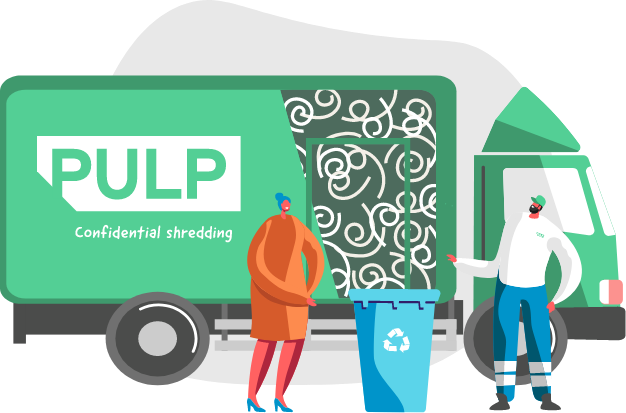
In our collective quest for sustainability, there are countless ways of moving the dial in the right direction. From the food we eat to the way we travel from place to place, almost everything we do has an impact on the environment, for better or worse. In the office, one of the most important things we can do is shred. But what happens to shredded paper? Why is it better for the environment than simply throwing it in the bin?
Sometimes, on our journey to become greener, it helps if we can see the impact of our actions. Failing that, it helps to understand how exactly our actions help the planet. When you use a shredding partner like Pulp, you make your organisation more secure and easier to keep tidy, but you also do a bit for the environment. In this week’s blog, we’ll talk about how.
What Happens to Shredded Paper?
Step 1: The Shredding Process
Pulp is a mobile shredding company, which means we shred all of your documents on-site using our trucks. Not only is this more efficient, but it is also more secure for you because it minimises the delay before we destroy your sensitive information. It also means the only people who handle your documents are our trained, Garda-vetted staff. Did you know that Pulp is one of only six NAID AAA-certified mobile shredders in Europe?
Our shredders can handle large amounts of paper all at once, regardless of whether or not there are any clips, binders or staples present. Your paper is shredded so finely that it’s instantly past the point of recovery, securing your confidential information.
Step 2: Making Bales
The next step in the process is to gather all of the shredded paper from the trucks into one of our warehouses. Once it arrives, we compress it into bales of paper. Paper mills can further process these bales and transform them into new, recycled paper products. Once we’ve finished compressing, we ship the bales out to one such paper mill.
Step 3: Making Pulp
What happens to shredded paper when it arrives at the paper mill? The bales have to go through a few more steps before they’re ready to become new products. The first of these is pulping. You mix the paper with water to break it down into pulp. We can eventually turn this substance into recycled paper, but it still has a long way to go before it’s ready for that.
Step 4: Removing Foreign Objects
Remember, when the paper was initially shredded, there were all sorts of foreign objects mixed in, such as clips and staples. The shredders can handle this material just fine, but it must be removed from the fresh pulp before the recycling process can proceed.
Normally, the first step in doing this is to force the pulp through a screen which filters out any unwanted objects and substances. Next, it is spun at high speeds. The centrifugal force removes the last of the contaminants.
Step 5: Removing Ink
Even after the paper has been through all of the above steps, the ink will still be present. The most common process for removing it is known as froth flotation. First, the pulp is immersed in a chemical solution that is designed to separate the ink from the fibres. Next, the solution is blasted with air bubbles which the ink sticks to. These bubbles float to the top where they can be skimmed away from the rest. The pulp is now ready to be dyed white.
Step 6: Drying
The final step that the pulp must go through before we turn it into new products is drying. There are a number of ways in which we do this.
- The pulp is laid on wire screens to dry
- Hot air is used to blast the pulp dry
- The pulp can be fed through a roller to press out excess water
Finally, we are ready to make new products. The shredded bales of paper have been transformed into usable material.
Step 7: New Products
Processed pulp is a versatile material that can be used in a wide range of household and industrial products. You may be surprised at the number of things your recycled, shredded paper ends up in! Here are some examples:
- Tissue paper
- Toilet paper
- Kitchen roll
- Cardboard
- Notebooks
- Printer paper
This process is more efficient than making fresh paper from scratch and also saves a huge number of trees from being cut down.
Wrapping Up
If you don’t shred your paper and throw it straight in the bin instead, it will end up as landfill. Not only is landfill ugly and inefficient, but it also results in toxic chemicals that harm the environment. On top of this, when you remove recycled paper from circulation, more trees have to be cut down to make up for the shortfall. Since we opened for business, Pulp’s efforts have saved over 400,000 trees. Call us today to find out more about our shredding services.






